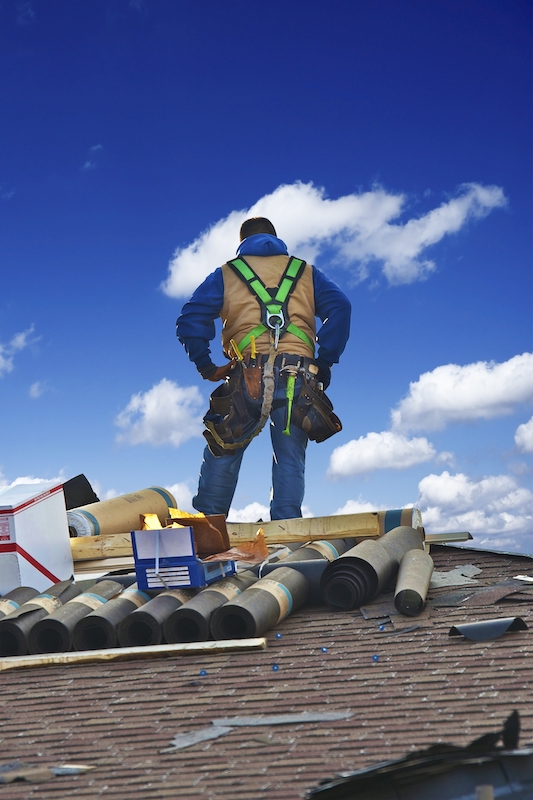With so many different types of roofing materials to choose from, a bit of research will help you decide whether to install a new type of roof rather than simply replacing with the same material you now have. When choosing roofing materials, consider the following questions.
• How heavy is this material, and will it require special framing?
• Is the material available in a variety of colors and styles that complement your home?
• Does the material meet the fire codes in your local area?
• Are there special installation and maintenance issues to consider?
• Does this material offer good performance in extreme weather conditions that are common in the Lowcountry?
• What is the cost, life span and warranty for this product?
The answers to these questions, along with the following information we’ve compiled, will help you determine the best choice for your home.
Asphalt shingles
Asphalt shingles are the most common roofing material in the U.S. because they are economical and easy to install. Made of a woven fiberglass base mat, covered with a waterproof asphalt coating, and topped with ceramic granules that shield the product from harmful UV rays, they are available in a full range of styles and colors to complement any home’s architectural style. Most are guaranteed up to 30 years, and replacing individual damaged shingles is easy. Virtually every roofing company is familiar with installing these shingles. Composite shingles excel at flexing and adapting to a roof’s movements due to expansion and contraction.
Pros: Asphalt comes in a variety of colors, is widely available and is one of the least expensive materials.
Cons: Asphalt has a shorter life span than other roofing materials, doesn’t provide the insulation other materials offer, and the quality varies.
House styles: Asphalt shingles work with many architectural styles, especially traditional suburban styles.
Cost and life span: Prices range from $70 to $120 a square and, if maintained properly, shingles will last 20 to 25 years.
Clay and concrete tiles
Clay and concrete tiles add texture and elegance to a roof. Genuine flat, ribbed, or scalloped clay tiles are extremely durable but also very heavy and must be installed by a professional. Concrete tiles are versatile and are less expensive than genuine clay but are also heavy. Concrete tiles are also more colorfast than clay.
Pros: Clay and concrete tiles are long-lasting and non-combustible. These are great options for hot climates where salt air and high winds are present.
Cons: Clay and concrete tiles are expensive, heavy, and usually require additional framing.
House styles: Clay and concrete tiles work well with Mediterranean, Mission, Southwestern and Spanish-style homes.
Cost and life span: Concrete $200-$800 / Clay $500-$1,000 per square installed. Life expectancy is 50 to 100 years.
Metal roofing
No material is better for protecting your home from wind, rain, hail, fire, or rot than a durable and energy-efficient metal roof. They come as panels or shingles, and different types of metal (aluminum, copper, stainless steel, and zinc). These roofs are sleek, lightweight, long-lasting, and recyclable, and great for rainwater harvesting. But installation requires special skills, and not every roofing company is prepared to install a standing seam metal roof.
For many years, having a metal roof meant corrugated panels, which to lots of people look like a barn roof. Currently, though, steel or aluminum shingles or shakes are available. Made from stamped metal and finished with either a high-quality baked-on coating or mineral granules, metal shingles can be fabricated to look very much like traditional asphalt shingles, wooden shakes, or even slate or clay tiles.
Pros: Metal roofing is durable, lasts longer than asphalt or wood, and offers high solar reflectance.
Cons: Metal roofing is relatively expensive, and installation may be an issue with some companies.
House styles: Metal looks great on bungalows, cabins, contemporary and cottage-style homes.
Cost and life span: Prices usually start around $100 to $300 per square, but some styles can cost $600 to $800 per square. Metal roofing can last 40 to 75 years.
Slate
A slate roof is perhaps the most beautiful roofing material there is—a choice for the most discriminating homeowner with the finest taste. Slate quarried for roofing is dense, sound rock, and is remarkably tough and durable. While installation is labor-intensive and costly, a natural slate look will give character to a building unlike any other roofing material. Available in lots of colors, slate tiles are non-combustible, waterproof, and require little to no maintenance over the course of a long life.
Pros: Slate is durable, fire-resistant, and sustainable roof material that can be recycled.
Cons: Slate is expensive, heavy, and requires extra framing and professional installation. The quality can vary with imported slate.
House styles: Slate works well with Colonial, European and French chateau homes.
Cost and life span: Prices start at about $600 per square and up. Slate can last more than 50 years and sometimes 100 years or more.
Wood shingles and shake
Wood roofs, though incredibly attractive, are also quite expensive and have limitations. They are not particularly long-lived, and they are a poor choice in areas that get lots of moisture or where wildfires are a danger. Still, they are beautiful, which makes them a popular choice for luxury homes.
Although both are made from natural wood, there is a difference between wood shakes and shingles. Shingles are typically thin, wedge-shaped slabs of wood that are produced by precise sawing. Shakes are produced by splitting wood, and they are thicker wedges with a rougher texture.
Pros: Wood shingles offer a rustic look and are a natural product usually made from cedar, redwood, and Southern pine.
Cons: Fire codes in some areas prohibit use. Wood shingles can be a concern in wet climates, and can mold, split, or rot.
House styles: Shake’s rustic aesthetic pairs well with bungalow, Cape Cod, cottage, Craftsman and Tudor-style homes.
Cost and life span: Shingles—about $4.50 to $9 per square foot, installed; shakes—around $6.50 to $11 per square foot, installed. In dry climates, a wood shingle or shake roof can last 60 years; in damp conditions, maybe 20 years.
Synthetic roofing products
If you want the look of slate, tile, or wood shake without the installation and maintenance costs, consider today’s composite roofing. Made from poly-based products, companies like CertainTeed, EcoStar, and DaVinci Roofscapes all offer superior products that are lightweight, fade-resistant, fire-safe, and warrantied for up to 50 years. Some are so realistic that they have been approved for use in historic preservation. They’re more durable, easier to install and much less expensive than authentic products.
Make sure to check with the manufacturer and inquire about warranty information. The National Roofing Contractors Association (NRCA) suggests you look at full-size samples of the synthetic product and the manufacturers’ brochures. Look for installations that have been in place at least 10 years to see what the wear characteristics of that material are in this area.
Pros: Synthetic roofing is often not as fragile, heavy, or expensive as natural products.
Cons: Some of these products can absorb water, and the quality varies. Newer products aren’t as time-tested as traditional materials.
House styles: Synthetic roofing products work with different architectural styles.
Cost and life span: Prices start at about $300 per square and are warrantied for up to 50 years.
Going green
Creating a green “living” roof is an investment that holds many benefits, among them better insulation, reduced run-off, and extended life to your roof. A green roof requires several layers of support vegetation, including a waterproofing membrane to protect the roof, and depending on the slope, probably a root barrier and irrigation system.
There are three types of living roofs: Intensive roofs will have a variety of vegetation and can be easily accessed for maintenance; extensive roofs will only support a light weight, such as a thin layer of soil and ground cover like mosses, and they usually require little attention from owners; semi-intensive roofs fall between these two.
Pros: A living roof offers improved air quality, less pollution, better insulation (reducing heating and cooling costs), water conservation, and wildlife habitat.
Cons: Green roofs are expensive to install. Reinforcing the roof of an existing home can necessitate expensive structural changes. Improper installation, inadequate drainage, or roots penetrating the protective membrane can cause leaks.
House styles: Green roofs work with many different architectural styles.
Cost and life span: Depending on intensive, extensive, or semi-intensive, costs range from $10-$50 per square foot; average lifespan when properly maintained is 40+ years.



